Structural Performance of Porcelain Insulators in Overhead Railway Power Systems: Experimental Evaluations and Findings
Abstract
:1. Introduction
2. Materials and Methods
2.1. Tension Tests
2.1.1. Experimental Setup
2.1.2. Instrumentation and Loading Protocol
2.2. CWRA Tests
2.2.1. Experimental Setup
2.2.2. Instrumentation and Loading Protocol
3. Experimental Results and Discussion
3.1. Tension Tests
3.1.1. Failure Modes
3.1.2. Load–Displacement Response
3.2. CWRA Tests
3.2.1. Failure Modes
3.2.2. Load–Displacement Response
4. Conclusions
Author Contributions
Funding
Data Availability Statement
Acknowledgments
Conflicts of Interest
References
- Gorur, R.S.; Cherney, E.A.; Burnham, J.T. Outdoor Insulators; Ravi, S., Ed.; Gorur Inc.: Phoenix, AZ, USA, 1999. [Google Scholar]
- Macey, R.E.; Vosloo, W.L.; Tourreil, C. The Practical Guide to Outdoor High Voltage Insulators; Crown Publications: New York, NY, USA, 2004. [Google Scholar]
- National Insulator Association. Available online: https://www.nia.org/ (accessed on 28 July 2023).
- Costea, M.; Baran, I. A comparative analysis of classical and composite insulators behavior. Univ. Politeh. Buchar. Sci. Bull. Ser. C Electr. Eng. 2012, 74, 147–154. [Google Scholar]
- Verma, A.R.; Reddy, B.S. Aging studies on polymeric insulators under DC stress with controlled climatic conditions. Polym. Test. 2018, 68, 185–192. [Google Scholar] [CrossRef]
- Venkataraman, S.; Gunasekaran, B. Case Study on Using Different Insulating Materials for Indian Railways Network, Performance Analysis of in-Service Composite Insulators & Recommendations for the Future. In Proceedings of the 2019 International Conference on High Voltage Engineering and Technology (ICHVET), Hyderabad, India, 7–8 February 2019; IEEE: New York, NY, USA, 2019; pp. 1–5. [Google Scholar]
- Verma, A.R.; Reddy, B.S. Interpretation of surface degradation on polymeric insulators. Eng. Fail. Anal. 2019, 95, 214–225. [Google Scholar] [CrossRef]
- Gao, Y.; Liang, X.; Bao, W.; Wu, C.; Li, S. Failure analysis of a field brittle fracture composite insulator: Characterisation by X-ray photoelectron spectroscopy analysis. High Volt. 2019, 4, 89–96. [Google Scholar] [CrossRef]
- Halloum, M.; Reddy, B.S. Investigations on the Failure of In-Service 400 kV Composite Insulator. IEEE Trans. Dielectr. Electr. Insul. 2023, 30, 2769–2778. [Google Scholar] [CrossRef]
- Ogbonna, V.E.; Popoola, P.I.; Popoola, O.M.; Adeosun, S.O. A comparative study on the failure analysis of field failed high voltage composite insulator core rods and recommendation of composite insulators: A review. Eng. Fail. Anal. 2022, 138, 106369. [Google Scholar] [CrossRef]
- Nagaraj, H.P.; Ravi, K.N.; Vasudev, N. Analysis of Brittle Fracture of Composite Insulators by Using Finite Element Technique. In Proceedings of the 2019 International Conference on High Voltage Engineering and Technology (ICHVET), Hyderabad, India, 7–8 February 2019; IEEE: New York, NY, USA, 2019; pp. 1–5. [Google Scholar]
- Cherney, E.A. Long-term mechanical life testing of polymeric post insulators for distribution and a comparison to porcelain. IEEE Trans. Power Del. 1988, 3, 1141–1145. [Google Scholar] [CrossRef]
- Takhirov, S.; Fenves, G.L.; Fujisaki, E. Seismic Qualification and Fragility Testing of Line Break 550-kV Disconnect Switches; Pacific Earthquake Engineering Research Center: Berkeley, CA, USA, 2005. [Google Scholar]
- Reinhorn, A.M.; Oikonomou, K.; Roh, H.; Schiff, A.; Kempner, J. Modeling and Seismic Performance Evaluation of High Voltage Transformers and Bushings; MCEER: Las Vegas, NV, USA, 2011. [Google Scholar]
- Moustafa, M.A.; Mosalam, K.M. Finite element modeling and assessment of seismic response of electrical substations porcelain post insulators. Soil Dyn. Earthq. Eng. 2021, 150, 106895. [Google Scholar] [CrossRef]
- Moustafa, M.A.; Mosalam, K.M. Structural performance of porcelain and polymer post insulators in high voltage electrical switches. J. Perform. Constr. Facil. 2016, 30, 04016002. [Google Scholar] [CrossRef]
- Gökçe, T.; Yüksel, E.; Orakdöğen, E. Failure mode investigation for high voltage porcelain insulators. In Proceedings of the 16th European Conference on Earthquake Engineering, Paper, Thessaloniki, Greece, 18–21 June 2018. [Google Scholar]
- Khalvati, A.H.; Hosseini, M.; Mohammadpour, S. Seismic behavior of 63kV and 132kV substation post insulators with flexible conductors, an experimental approach. J. Seismol. Earthq. Eng. 2011, 13, 77–92. [Google Scholar]
- Mohammadpour, S.; Hosseini, M. Experimental system identification of a 63kV substation post insulator and the development of its fragility curves by dynamic finite element analyses. Earthq. Spectra 2017, 33, 1149–1172. [Google Scholar] [CrossRef]
- Reddy, B.S.; Ramamurthy, P.C. Analysis of in-service composite insulators used in overhead railway traction. Eng. Fail. Anal. 2020, 108, 104227. [Google Scholar] [CrossRef]
- Muangpratoom, P.; Khonchaiyaphum, I.; Vittayakorn, W. Improvement of the Electrical Performance of Outdoor Porcelain Insulators by Utilization of a Novel Nano-TiO2 Coating for Application in Railway Electrification Systems. Energies 2023, 16, 561. [Google Scholar] [CrossRef]
- Wang, Z.; Liu, X.; Peng, H.; Zheng, L.; Gao, J.; Bao, Y. Railway Insulator Detection Based on Adaptive Cascaded Convolutional Neural Network; IEEE Access: New York, NY, USA, 2021; Volume 9, pp. 115676–115686. [Google Scholar]
- VT/OCS—Overhead Contact Systems IEEE Recommended Practice for Terminology Used for Direct Current Electric Transit Overhead Contact Systems. 2019. Available online: https://standards.ieee.org/ieee/1791/5894/ (accessed on 1 August 2024).
- ANSI/NEMA C29.9-2017; Wet-Process Porcelain Insulators—Apparatus, Post Type. NEMA: National Electrical Manufacturers Association: Virginia, VA, USA, 2017. Available online: https://webstore.ansi.org/standards/nema/ansinemac292017-1669325 (accessed on 1 August 2024).
- ANSI/NEMA C29.1-2018; Test Methods for Electrical Power Insulators. NEMA: National Electrical Manufacturers Association: Virginia, VA, USA, 2018. Available online: https://webstore.ansi.org/standards/nema/ansinemac292018 (accessed on 1 August 2024).
- Beer, F.; Johnston, E.; DeWolf, J.; Mazurek, D. Mechanics of Materials; Mc Graw Hill: New York, NY, USA, 2020. [Google Scholar]

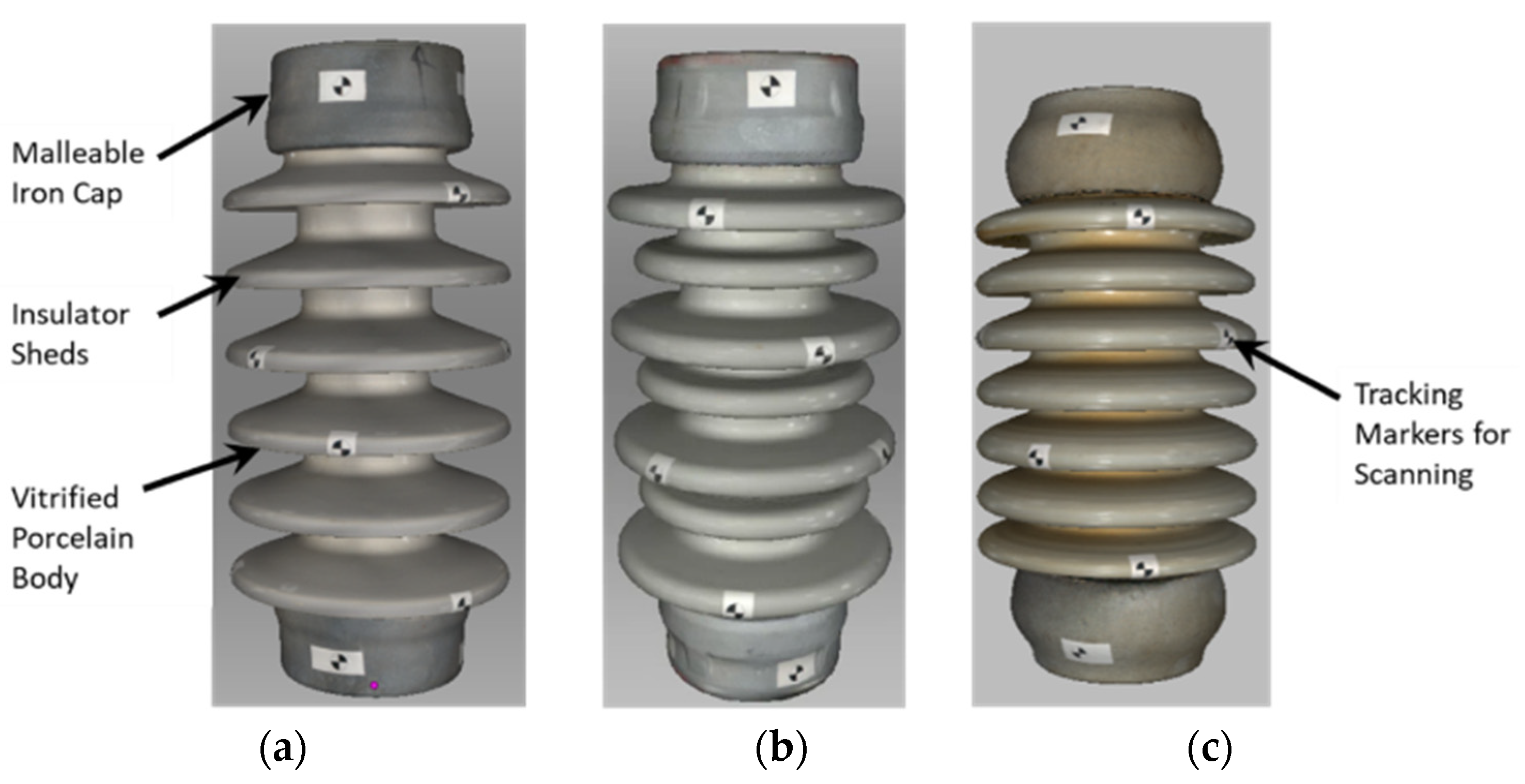
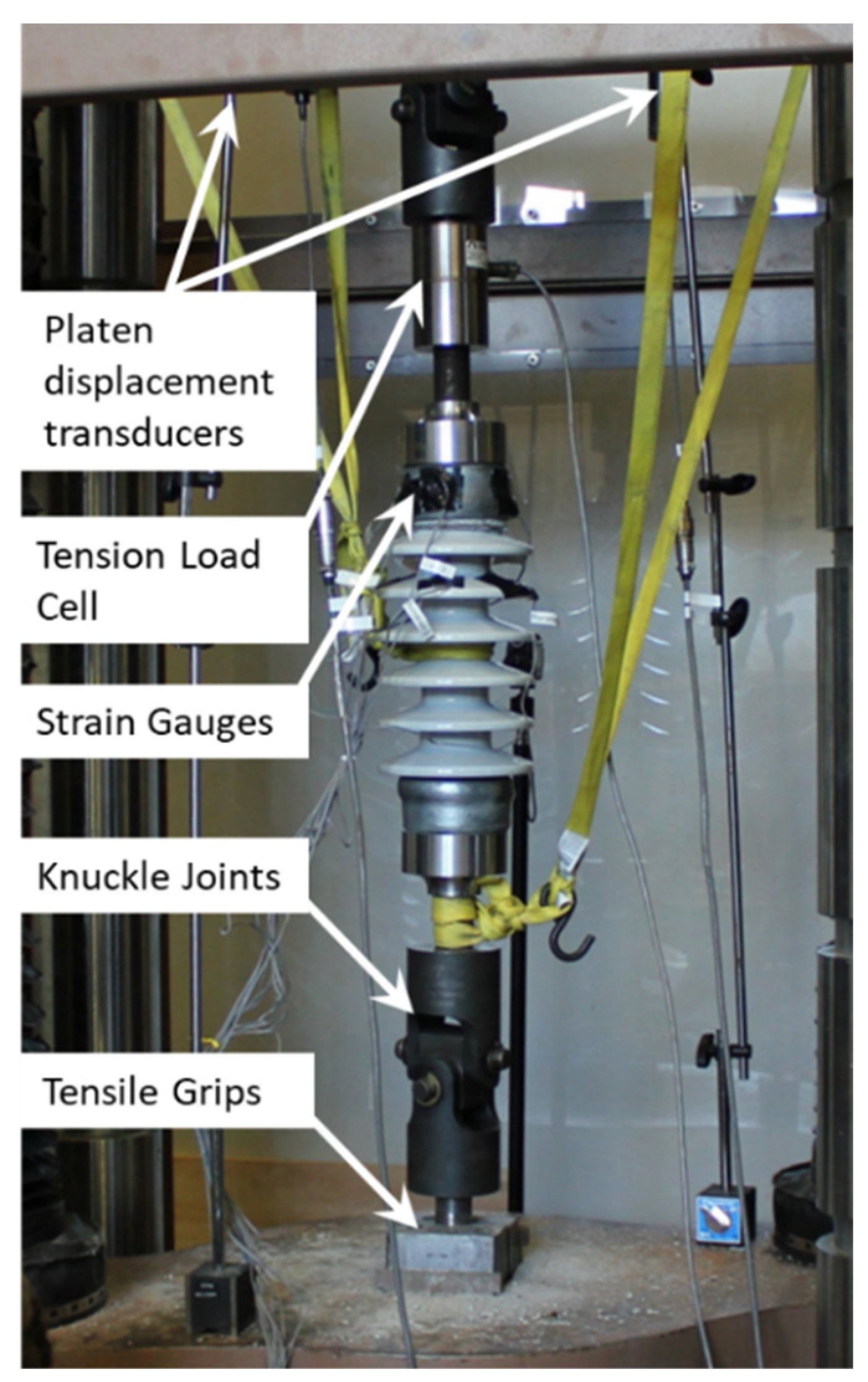



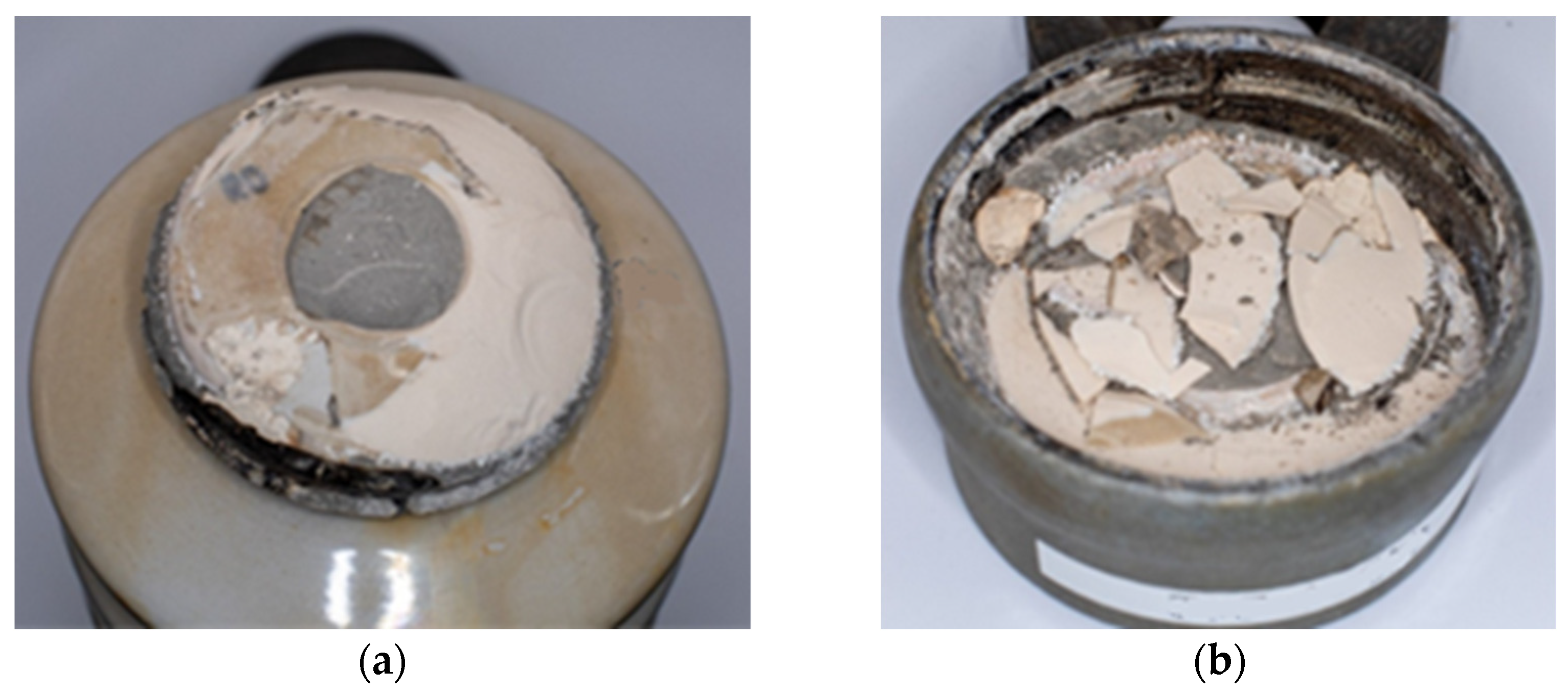
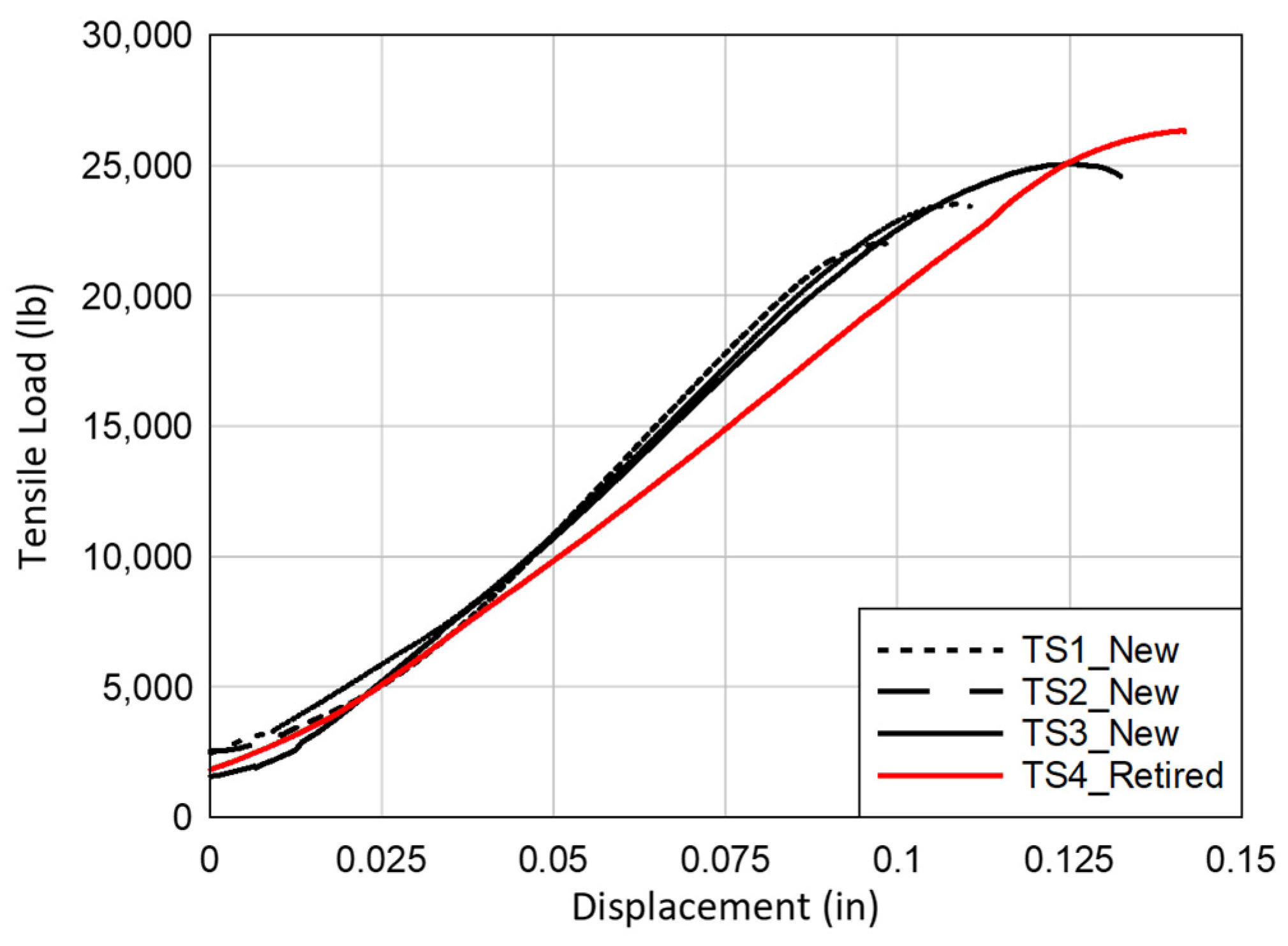
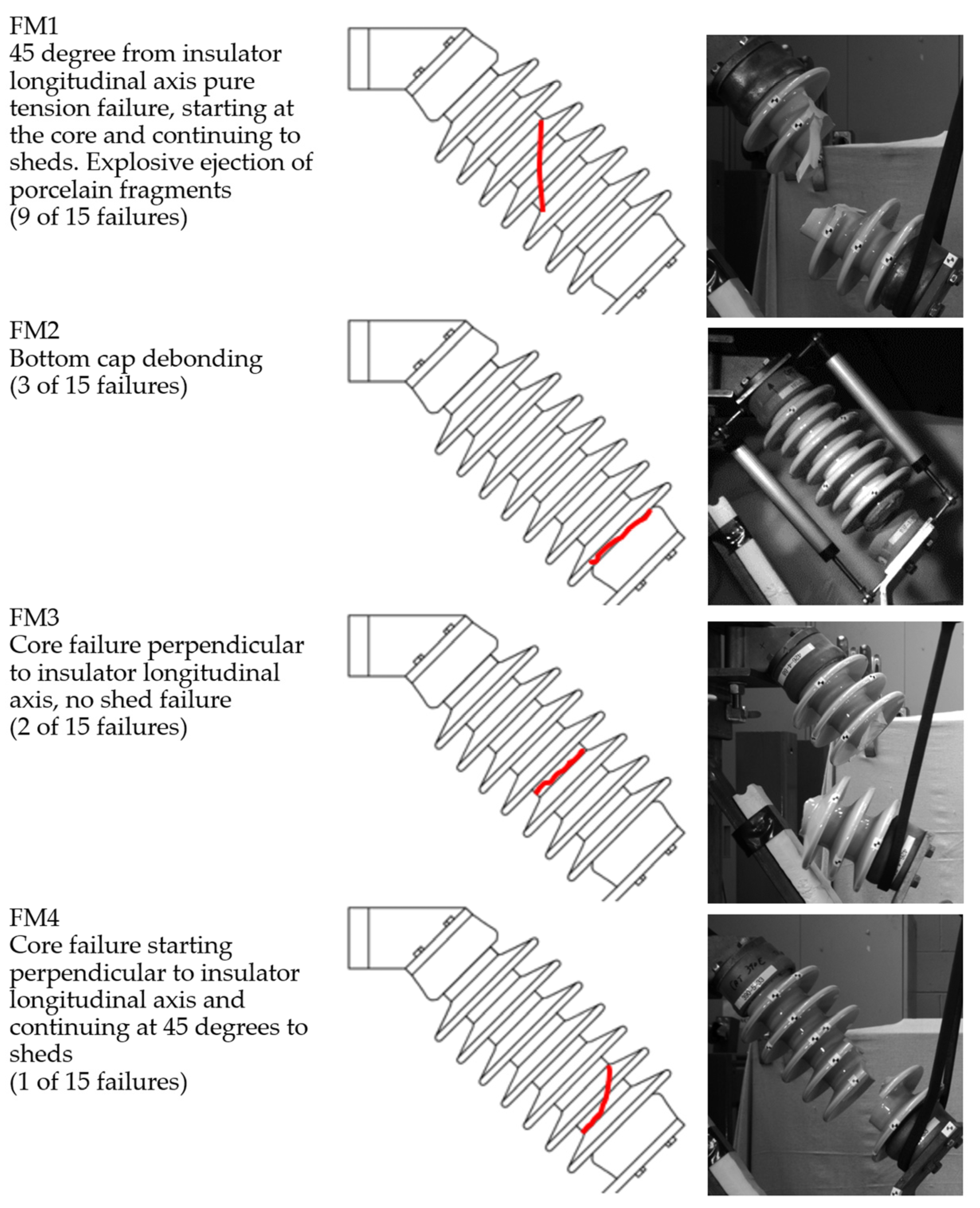

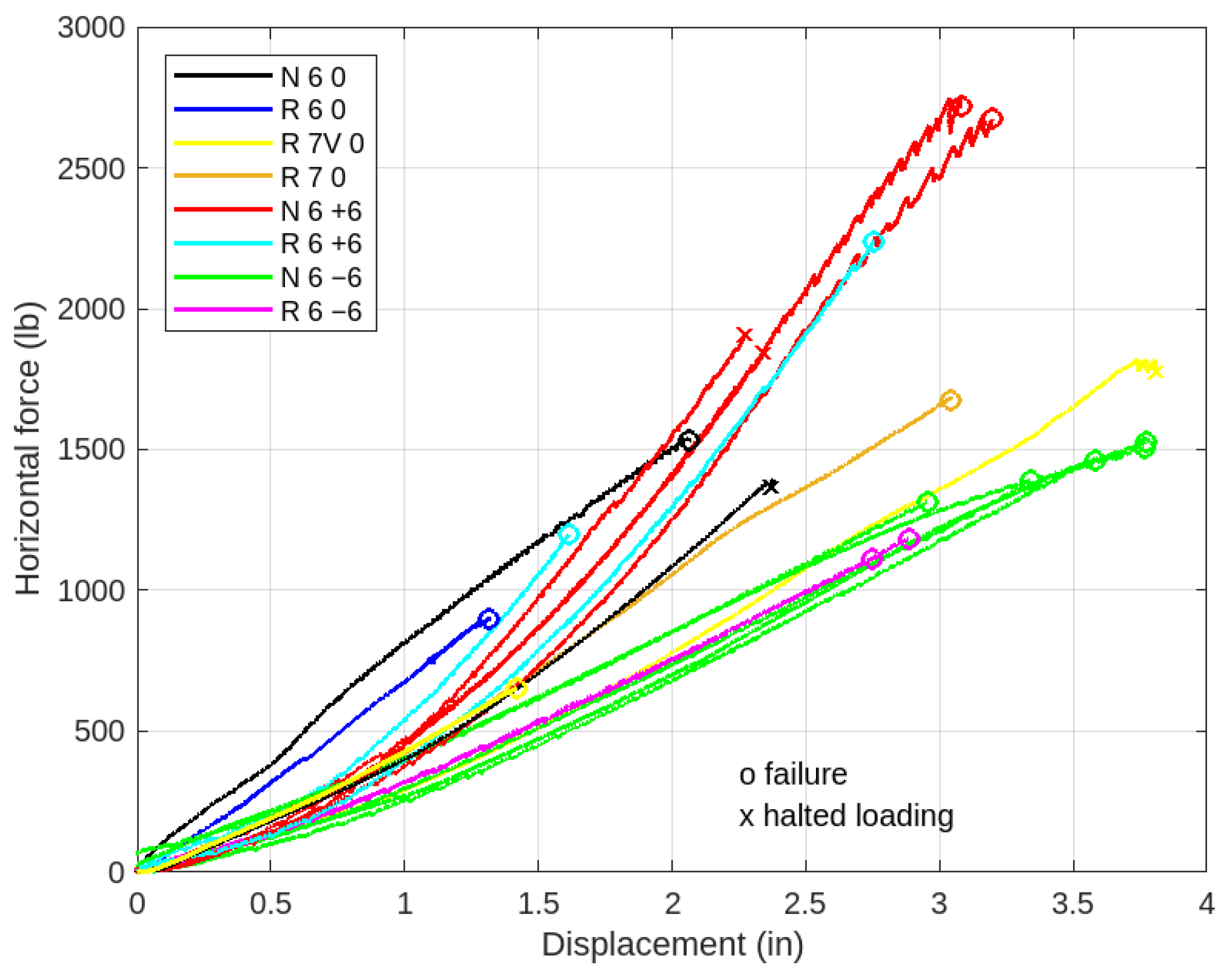
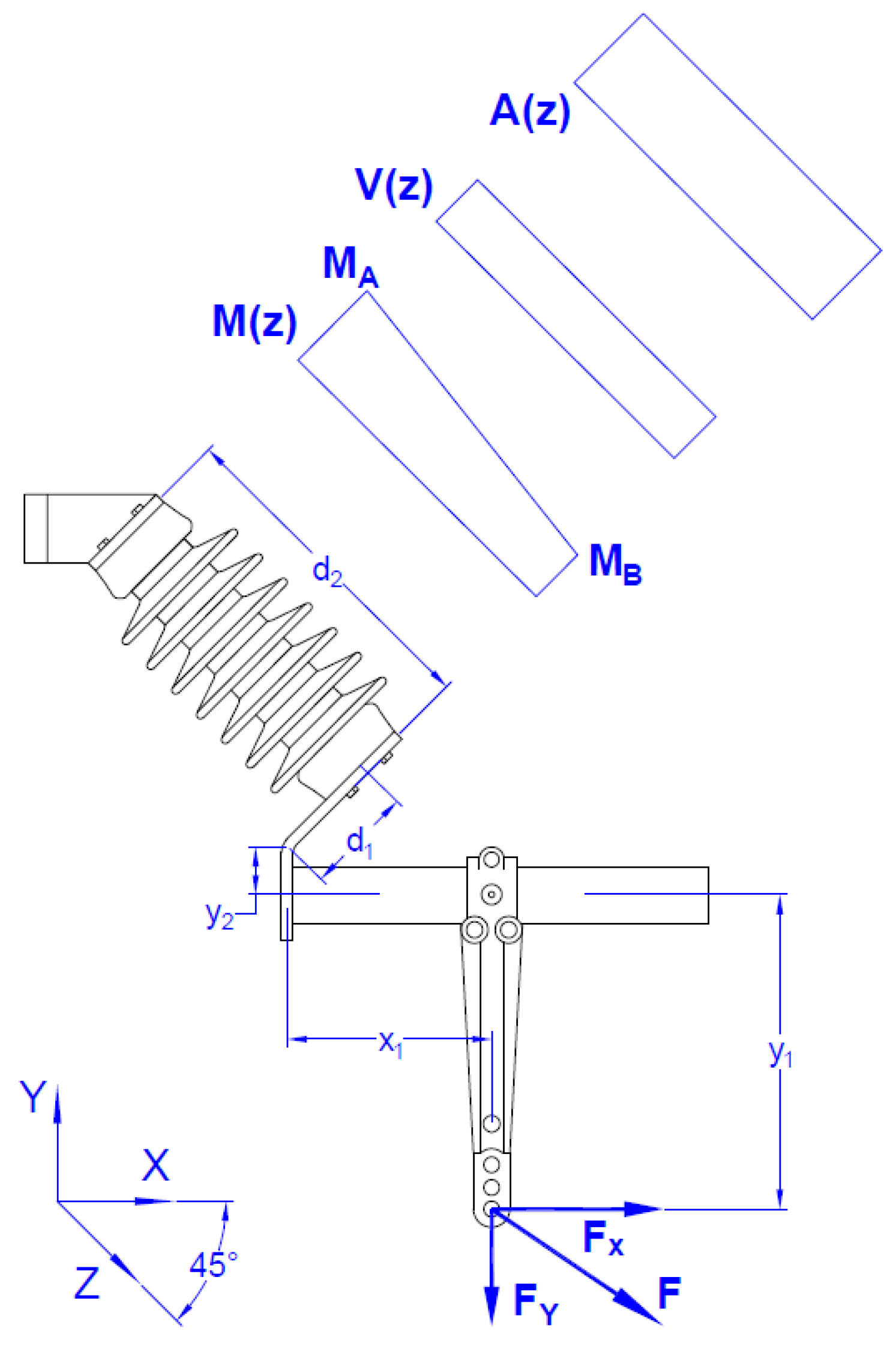
| Test ID | Insulator Condition | Max Load (kN) | Max Load (kip) |
|---|---|---|---|
| TS1 | New | 109.0 | 24.5 |
| TS2 | New | 104.5 | 23.5 |
| TS3 | New | 111.2 | 25.0 |
| TS4 | Retired | 117.9 | 26.5 |
| Test ID | Insulator Condition | Geometry (Sheds) | Offset (mm) | Fmax (kN) | Fmax (lb) | Failure Mode | fmax (MPa) | fmax (ksi) |
|---|---|---|---|---|---|---|---|---|
| N 6 0 | New | 6 | 0 | 6.85 | 1540.0 | FM3 | 53.91 | 7.82 |
| N 6 0 | New | 6 | 0 | 6.22 | 1398.3 | NA | 62.93 | 9.13 |
| R 6 0 | Retired | 6 | 0 | 4.01 | 901.6 | FM2 | 38.22 | 5.54 |
| R 7V 0 | Retired | 7V | 0 | 2.94 | 662.0 | FM2 | 10.73 | 1.56 |
| R 7 0 | Retired | 7 | 0 | 8.03 | 1806.4 | FM2 | 12.45 | 1.81 |
| R 7V 0 | Retired | 7V | 0 | 8.78 | 1974.2 | NA | 67.58 | 9.80 |
| N_6_+6 | New | 6 | +152 | 13.28 | 2985.0 | FM1 | 88.04 | 12.77 |
| N 6 +6 | New | 6 | +152 | 13.50 | 3036.1 | FM1 | 70.90 | 10.28 |
| N_6_+6 | New | 6 | +152 | 9.09 | 2044.0 | NA | 69.50 | 10.08 |
| N 6 +6 | New | 6 | +152 | 8.95 | 2012.0 | NA | 62.78 | 9.11 |
| R_6_+6 | Retired | 6 | +152 | 5.66 | 1273.0 | FM4 | 21.29 | 3.09 |
| R 6 +6 | Retired | 6 | +152 | 10.96 | 2465.0 | FM1 | 51.98 | 7.54 |
| N_6_−6 | New | 6 | −152 | 6.82 | 1533.0 | FM1 | 78.81 | 11.43 |
| N 6 −6 | New | 6 | −152 | 6.29 | 1415.0 | FM1 | 71.87 | 10.42 |
| N_6_−6 | New | 6 | −152 | 6.95 | 1562.0 | FM1 | 71.13 | 10.32 |
| N 6 −6 | New | 6 | −152 | 6.03 | 1356.0 | FM1 | 64.85 | 9.41 |
| N_6_−6 | New | 6 | −152 | 6.79 | 1527.0 | FM1 | 73.33 | 10.64 |
| R 6 −6 | Retired | 6 | −152 | 5.10 | 1147.0 | FM3 | 36.21 | 5.25 |
| R_6_−6 | Retired | 6 | −152 | 5.45 | 1225.0 | FM1 | 39.59 | 5.74 |
Disclaimer/Publisher’s Note: The statements, opinions and data contained in all publications are solely those of the individual author(s) and contributor(s) and not of MDPI and/or the editor(s). MDPI and/or the editor(s) disclaim responsibility for any injury to people or property resulting from any ideas, methods, instructions or products referred to in the content. |
© 2024 by the authors. Licensee MDPI, Basel, Switzerland. This article is an open access article distributed under the terms and conditions of the Creative Commons Attribution (CC BY) license (https://creativecommons.org/licenses/by/4.0/).
Share and Cite
Agüero-Barrantes, P.; Hain, A. Structural Performance of Porcelain Insulators in Overhead Railway Power Systems: Experimental Evaluations and Findings. Infrastructures 2024, 9, 138. https://doi.org/10.3390/infrastructures9080138
Agüero-Barrantes P, Hain A. Structural Performance of Porcelain Insulators in Overhead Railway Power Systems: Experimental Evaluations and Findings. Infrastructures. 2024; 9(8):138. https://doi.org/10.3390/infrastructures9080138
Chicago/Turabian StyleAgüero-Barrantes, Pablo, and Alexandra Hain. 2024. "Structural Performance of Porcelain Insulators in Overhead Railway Power Systems: Experimental Evaluations and Findings" Infrastructures 9, no. 8: 138. https://doi.org/10.3390/infrastructures9080138







